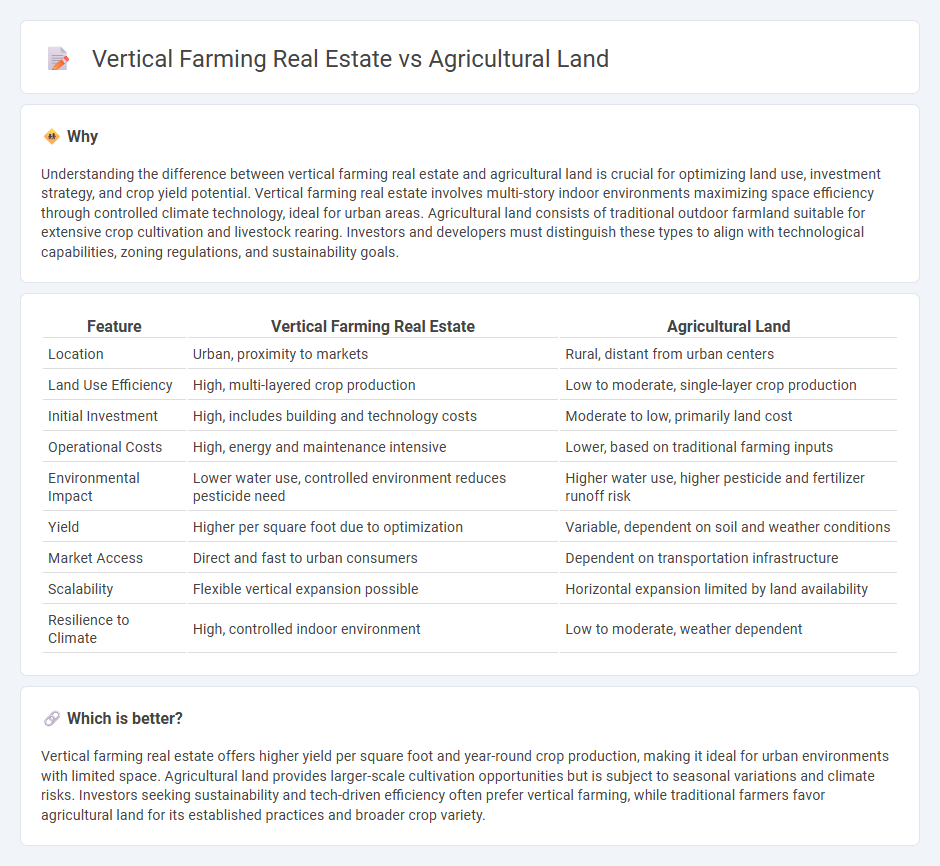
Vertical farming real estate maximizes urban space through multi-level, controlled-environment agriculture, resulting in higher crop yields per square foot than traditional agricultural land. This innovative approach reduces water usage and eliminates the need for pesticides, offering sustainable solutions amid shrinking arable land. Discover how vertical farming real estate is transforming future food production and investment opportunities.
Why it is important
Understanding the difference between vertical farming real estate and agricultural land is crucial for optimizing land use, investment strategy, and crop yield potential. Vertical farming real estate involves multi-story indoor environments maximizing space efficiency through controlled climate technology, ideal for urban areas. Agricultural land consists of traditional outdoor farmland suitable for extensive crop cultivation and livestock rearing. Investors and developers must distinguish these types to align with technological capabilities, zoning regulations, and sustainability goals.
Comparison Table
| Feature | Vertical Farming Real Estate | Agricultural Land |
|---|---|---|
| Location | Urban, proximity to markets | Rural, distant from urban centers |
| Land Use Efficiency | High, multi-layered crop production | Low to moderate, single-layer crop production |
| Initial Investment | High, includes building and technology costs | Moderate to low, primarily land cost |
| Operational Costs | High, energy and maintenance intensive | Lower, based on traditional farming inputs |
| Environmental Impact | Lower water use, controlled environment reduces pesticide need | Higher water use, higher pesticide and fertilizer runoff risk |
| Yield | Higher per square foot due to optimization | Variable, dependent on soil and weather conditions |
| Market Access | Direct and fast to urban consumers | Dependent on transportation infrastructure |
| Scalability | Flexible vertical expansion possible | Horizontal expansion limited by land availability |
| Resilience to Climate | High, controlled indoor environment | Low to moderate, weather dependent |
Which is better?
Vertical farming real estate offers higher yield per square foot and year-round crop production, making it ideal for urban environments with limited space. Agricultural land provides larger-scale cultivation opportunities but is subject to seasonal variations and climate risks. Investors seeking sustainability and tech-driven efficiency often prefer vertical farming, while traditional farmers favor agricultural land for its established practices and broader crop variety.
Connection
Vertical farming real estate maximizes urban land use by integrating agricultural production within multi-story buildings, reducing dependency on traditional agricultural land. This approach transforms real estate into productive spaces that support sustainable food systems and lessen pressure on rural farmland. The synergy between vertical farming infrastructure and agricultural land enhances local food security while optimizing land resource allocation.
Key Terms
Land Use Zoning
Land use zoning plays a critical role in differentiating agricultural land from vertical farming real estate by regulating permissible activities and construction types on designated parcels. Agricultural land zoning typically permits traditional farming practices and limits structural developments, whereas vertical farming requires zoning allowances for high-tech buildings and urban integration. Explore how evolving zoning policies can impact sustainable food production and urban real estate development.
Yield per Acre
Agricultural land typically yields 2 to 3 tons of crops per acre annually, depending on the crop and soil quality, whereas vertical farming can produce up to 10 times higher yield per acre by utilizing multi-layered growth systems and controlled environments. Vertical farms optimize space, water use, and nutrient delivery, resulting in consistent, year-round production with reduced crop loss. Explore more about vertical farming innovations and their impact on maximizing agricultural real estate efficiency.
Facility Infrastructure
Agricultural land requires extensive open space, natural soil conditions, and water access, while vertical farming real estate prioritizes controlled environment facilities with advanced HVAC systems, LED lighting, and hydroponic setups. Vertical farming infrastructure demands higher capital investment but offers greater yield per square foot through multi-layered growing platforms and climate control technologies. Explore further to understand how facility infrastructure impacts the efficiency and sustainability of these farming methods.
Source and External Links
Agricultural land - Agricultural land is land devoted to agriculture, covering about 38.4% of the world's land area as of 2011.
Asheville, NC Farm Land for Sale - There are currently farms for sale near Asheville, with an average listing price and varying costs per acre based on different listings.
Agricultural Land Easements - North Carolina - The NRCS provides financial assistance for purchasing Agricultural Land Easements to protect agricultural use and conservation values in North Carolina.
 dowidth.com
dowidth.com